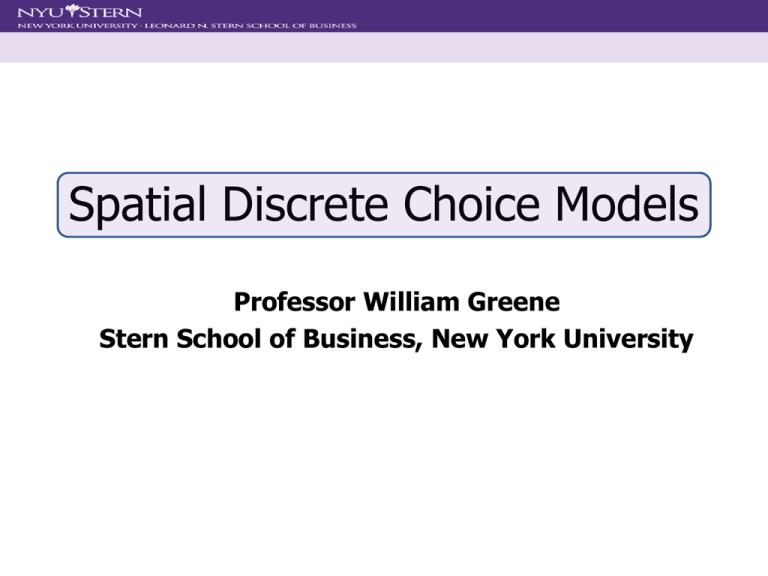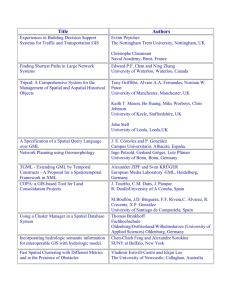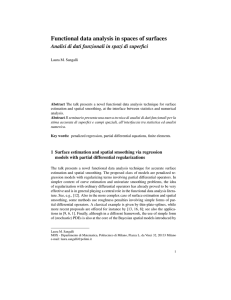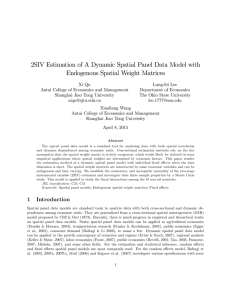SpatialData - NYU Stern School of Business
advertisement

Spatial Discrete Choice Models
Professor William Greene
Stern School of Business, New York University
Spatial Correlation
Spatially Autocorrelated Data
Per Capita Income in
Monroe County, New
York, USA
The Hypothesis of Spatial Autocorrelation
Spatial Discrete Choice Modeling: Agenda
Linear Models with Spatial Correlation
Discrete Choice Models
Spatial Correlation in Nonlinear Models
Basics of Discrete Choice Models
Maximum Likelihood Estimation
Spatial Correlation in Discrete Choice
Binary Choice
Ordered Choice
Unordered Multinomial Choice
Models for Counts
Linear Spatial Autocorrelation
( x i) W( x i) ε , N observations on a spatially
arranged variable
W ' contiguity matrix;' Wii 0
W must be specified in advance. It is not estimated.
spatial autocorrelation parameter, -1 < < 1.
E[ε]=0,
Var[ε]=2 I
( x i) [I W]1 ε = Spatial "moving average" form
E[x ]=i, Var[x ]=2 [(I W)(I W)]-1
Testing for Spatial Autocorrelation
Spatial Autocorrelation
y Xβ Wε.
E[ε|X]=0,
Var[ε|X]=2 I
E[y|X]=Xβ
Var[y|X] = 2 2 WW
A Generalized Regression Model
Spatial Autoregression in a Linear Model
y Wy + Xβ ε.
E[ε|X]=0,
2
Var[ε|X]= I
y [I W]1 (Xβ ε)
[I W]1 Xβ [I W]1 ε
E[y|X]=[I W]1 Xβ
-1
Var[y|X] = [(I W) (I W)]
2
Complications of the Generalized
Regression Model
Potentially very large N – GPS data on agriculture
plots
Estimation of . There is no natural residual based
estimator
Complicated covariance structure – no simple
transformations
Panel Data Application
E.g., N countries, T periods (e.g., gasoline data)
y it x it β c i it
ε t Wε t v t = N observations at time t.
Similar assumptions
Candidate for SUR or Spatial Autocorrelation model.
Spatial Autocorrelation in a Panel
Alternative Panel Formulations
Pure space-recursive - dependence pertains to neighbors in period t-1
y i,t [Wy t 1 ] i regression + it
Time-space recursive - dependence is pure autoregressive and on neighbors
in period t-1
y i,t y i,t-1 + [Wy t 1 ] i regression + it
Time-space simultaneous - dependence is autoregressive and on neighbors
in the current period
y i,t y i,t-1 + [Wy t ] i regression + it
Time-space dynamic - dependence is autoregressive and on neighbors
in both current and last period
y i,t y i,t-1 + [Wy t ] i + [Wy t 1 ] i regression + it
Analytical Environment
Generalized linear regression
Complicated disturbance covariance
matrix
Estimation platform
Generalized least squares
Maximum likelihood estimation when normally
distributed disturbances (still GLS)
Discrete Choices
Land use intensity in Austin, Texas –
Intensity = 1,2,3,4
Land Usage Types in France, 1,2,3
Oak Tree Regeneration in Pennsylvania
Number = 0,1,2,… (Many zeros)
Teenagers physically active = 1 or
physically inactive = 0, in Bay Area, CA.
Discrete Choice Modeling
Discrete outcome reveals a specific choice
Underlying preferences are modeled
Models for observed data are usually not
conditional means
Generally, probabilities of outcomes
Nonlinear models – cannot be estimated by any
type of linear least squares
Discrete Outcomes
Discrete Revelation of Underlying
Preferences
Binary choice between two alternatives
Unordered choice among multiple alternatives
Ordered choice revealing underlying strength
of preferences
Counts of Events
Simple Binary Choice: Insurance
Redefined Multinomial Choice
Fly
Ground
Multinomial Unordered Choice - Transport Mode
Health Satisfaction (HSAT)
Self administered survey: Health Care Satisfaction? (0 – 10)
Continuous Preference Scale
Ordered Preferences at IMDB.com
Counts of Events
Modeling Discrete Outcomes
“Dependent Variable” typically labels an
outcome
No quantitative meaning
Conditional relationship to covariates
No “regression” relationship in most cases
The “model” is usually a probability
Simple Binary Choice: Insurance
Decision: Yes or No = 1 or 0
Depends on Income, Health, Marital Status, Gender
Multinomial Unordered Choice - Transport Mode
Decision: Which Type, A, T, B, C.
Depends on Income, Price, Travel Time
Health Satisfaction (HSAT)
Self administered survey: Health Care Satisfaction? (0 – 10)
Outcome: Preference = 0,1,2,…,10
Depends on Income, Marital Status, Children, Age, Gender
Counts of Events
Outcome: How many events at each location = 0,1,…,10
Depends on Season, Population, Economic Activity
Nonlinear Spatial Modeling
Discrete outcome yit = 0, 1, …, J for
some finite or infinite (count case) J.
i = 1,…,n
t = 1,…,T
Covariates xit .
Conditional Probability (yit = j)
= a function of xit.
Two Platforms
Random Utility for Preference Models
Outcome reveals underlying utility
Binary: u* = ’x y = 1 if u* > 0
Ordered: u* = ’x y = j if j-1 < u* < j
Unordered: u*(j) = ’xj , y = j if u*(j) > u*(k)
Nonlinear Regression for Count Models
Outcome is governed by a nonlinear
regression
E[y|x] = g(,x)
Probit and Logit Models
Prob(yi 1 or 0|xi ) = F(θxi ) or [1- F(θxi )]
Implied Regression Function
Estimated Binary Choice Models:
The Results Depend on F(ε)
LOGIT
Variable
EXTREME
Estimate
VALUE
t-ratio
Estimate
t-ratio
-0.42085
-2.662
-0.25179
-2.600
0.00960
0.078
X1
0.02365
7.205
0.01445
7.257
0.01878
7.129
X2
-0.44198
-2.610
-0.27128
-2.635
-0.32343
-2.536
X3
0.63825
8.453
0.38685
8.472
0.52280
8.407
Constant
Estimate
PROBIT
t-ratio
Log-L
-2097.48
-2097.35
-2098.17
Log-L(0)
-2169.27
-2169.27
-2169.27
Effect on Predicted Probability
of an Increase in X1
+ 1 (X1+1) + 2 (X2) + 3 X3 (1 is positive)
Estimated Partial Effects vs. Coefficients
Applications: Health Care Usage
German Health Care Usage Data, 7,293 Individuals, Varying Numbers of Periods
Variables in the file are
Data downloaded from Journal of Applied Econometrics Archive. This is an unbalanced panel with 7,293
individuals. They can be used for regression, count models, binary choice, ordered choice, and bivariate binary
choice. This is a large data set. There are altogether 27,326 observations. The number of observations ranges
from 1 to 7. (Frequencies are: 1=1525, 2=2158, 3=825, 4=926, 5=1051, 6=1000, 7=987). (Downloaded from the
JAE Archive)
DOCTOR
HOSPITAL
HSAT
DOCVIS
HOSPVIS
PUBLIC
ADDON
HHNINC
HHKIDS
EDUC
AGE
FEMALE
EDUC
= 1(Number of doctor visits > 0)
= 1(Number of hospital visits > 0)
= health satisfaction, coded 0 (low) - 10 (high)
= number of doctor visits in last three months
= number of hospital visits in last calendar year
= insured in public health insurance = 1; otherwise = 0
= insured by add-on insurance = 1; otherswise = 0
= household nominal monthly net income in German marks / 10000.
(4 observations with income=0 were dropped)
= children under age 16 in the household = 1; otherwise = 0
= years of schooling
= age in years
= 1 for female headed household, 0 for male
= years of education
An Estimated Binary Choice Model
An Estimated Ordered Choice Model
An Estimated Count Data Model
210 Observations on Travel Mode Choice
CHOICE
MODE
TRAVEL
AIR
.00000
TRAIN
.00000
BUS
.00000
CAR
1.0000
AIR
.00000
TRAIN
.00000
BUS
.00000
CAR
1.0000
AIR
.00000
TRAIN
.00000
BUS
1.0000
CAR
.00000
AIR
.00000
TRAIN
.00000
BUS
.00000
CAR
1.0000
INVC
59.000
31.000
25.000
10.000
58.000
31.000
25.000
11.000
127.00
109.00
52.000
50.000
44.000
25.000
20.000
5.0000
ATTRIBUTES
INVT
TTME
100.00
69.000
372.00
34.000
417.00
35.000
180.00
.00000
68.000
64.000
354.00
44.000
399.00
53.000
255.00
.00000
193.00
69.000
888.00
34.000
1025.0
60.000
892.00
.00000
100.00
64.000
351.00
44.000
361.00
53.000
180.00
.00000
GC
70.000
71.000
70.000
30.000
68.000
84.000
85.000
50.000
148.00
205.00
163.00
147.00
59.000
78.000
75.000
32.000
CHARACTERISTIC
HINC
35.000
35.000
35.000
35.000
30.000
30.000
30.000
30.000
60.000
60.000
60.000
60.000
70.000
70.000
70.000
70.000
An Estimated Unordered Choice Model
Maximum Likelihood Estimation
Cross Section Case
Binary Outcome
Random Utility:
y* = x +
Observed Outcome: y = 1 if y* > 0,
0 if y* 0.
Probabilities: P(y=1|x) = Prob(y* > 0|x )
= Prob( > -x)
P(y=0|x) = Prob(y* 0|x )
= Prob( -x )
Likelihood for the sample = joint probability
=
Log Likelihood
=
i
n
i
n
1
1
Prob(y=y i|x i )
logProb(y=y i|x i )
Cross Section Case
y1
y
Prob 2
yn
x1
x 2
x n
or > x1 )
or > x 2 )
...
or > x n )
j | x1
1 or >
j | x2
or >
Prob 2
...
...
j | x n
n or >
=
Prob(1
Prob(2
Prob(n
We operate on the marginal probabilities of n observations
Log Likelihoods for Binary Choice Models
Logl(|X, y )= i 1 logF 2y i 1 x i
Probit
t
1
F(t) = (t)
exp( t 2 / 2)dt
2
n
t
(t)dt
Logit
exp(t)
F(t) = (t) =
1 exp(t)
Spatially Correlated Observations
Correlation Based on Unobservables
y 1 x1 u1
y 2 x 2 u2
...
y n x n un
0
u1
1
u
2 W 2 ~ f 0 , 2 WW
...
...
...
0
un
n
W = the usual spatial weight matrix.
In the cross section case, W= I. Now, it is a full
matrix. The joint probably is a single n fold integral.
Spatially Correlated Observations
Correlated Utilities
y 1*
y 1* x1 1
x1 1
*
*
y 2 W y 2 x 2 2 I W 1 x 2 2
...
...
...
...
*
*
x n n
yn
y n x n n
W = the usual spatial weight matrix.
In the cross section case, W = I. Now, it is a full
matrix. The joint probably is a single n fold integral.
Log Likelihood
In the unrestricted spatial case, the log
likelihood is one term,
LogL = log Prob(y1|x1, y2|x2, … ,yn|xn)
In the discrete choice case, the
probability will be an n fold integral,
usually for a normal distribution.
LogL for an Unrestricted BC Model
LogL(|X, y)=log
x n
...
x1
q 11
1
q 1q 2w 12
q
qqw
1
n 2 2 1 2 21
... ...
...
q n n q n q 1w n 1 q n q 2w n 2
... q 1q nw 1n
... q 2q nw 2n
d
...
...
...
1
1
2
...
n
q i 1 if y i = 0 and +1 if y i = 1.
One huge observation - n dimensional normal integral.
Not feasible for any reasonable sample size.
Even if computable, provides no device for estimating sampling standard errors.
Solution Approaches for Binary Choice
Distinguish between private and
social shocks and use pseudo-ML
Approximate the joint density and
use GMM with the EM algorithm
Parameterize the spatial correlation
and use copula methods
Define neighborhoods – make W a
sparse matrix and use pseudo-ML
Others …
Pseudo Maximum Likelihood
Smirnov, A., “Modeling Spatial Discrete Choice,” Regional Science and Urban Economics, 40, 2010.
Spatial Autoregression in Utilities
y* Wy * X , y 1( y* 0) for all n individuals
y* (I W) 1 X (I W) 1
(I W) 1 t 0 (W)t assumed convergent
= A
= D + A -D
where D = diagonal elements
y* AX D
A - D
Private
Social
Suppose individuals ignore the social "shocks." Then
nj 1aij x j
Prob[y i 1 or 0 | X] F (2y i 1)
di
, probit or logit.
Pseudo Maximum Likelihood
Assumes away the correlation in the
reduced form
Makes a behavioral assumption
Requires inversion of (I-W)
Computation of (I-W) is part of the
optimization process - is estimated
with .
Does not require multidimensional
integration (for a logit model, requires no
integration)
GMM
Pinske, J. and Slade, M., (1998) “Contracting in Space: An Application of Spatial Statistics to Discrete Choice
Models,” Journal of Econometrics, 85, 1, 125-154.
Pinkse, J. , Slade, M. and Shen, L (2006) “Dynamic Spatial Discrete Choice Using One Step GMM: An Application to
Mine Operating Decisions”, Spatial Economic Analysis, 1: 1, 53 — 99.
y*=Xθ+, = Wε+u
= [I-W]1u
= Au
Cross section case: =0
Probit Model: FOC for estimation of is based on the
ˆi = y i E [ | y i ]
generalized residuals u
(y i (x i ))(x i )
x
i 1 i (x )[1 (x )] = 0
i
i
Spatially autocorrelated case: Moment equations are still
valid. Complication is computing the variance of the moment
n
equations, which requires some approximations.
GMM
y*=Xθ+, = Wε+u
= [I-W]1u
= Au
Autocorrelated Case: 0
Probit Model: FOC for estimation of is based on the
ˆi = y i E [ | y i ]
generalized residuals u
i
n
1
x i x i
y i
a ii () a ii ()
zi
=0
x i 1 x i
a ii ()
a
(
)
ii
Requires at least K +1 instrumental variables.
GMM Approach
Spatial autocorrelation induces
heteroscedasticity that is a function of
Moment equations include the
heteroscedasticity and an additional
instrumental variable for identifying .
LM test of = 0 is carried out under the null
hypothesis that = 0.
Application: Contract type in pricing for 118
Vancouver service stations.
Copula Method and Parameterization
Bhat, C. and Sener, I., (2009) “A copula-based closed-form binary logit choice model
for accommodating spatial correlation across observational units,” Journal of Geographical Systems, 11, 243–272
Basic Logit Model
y *i x i i , y i 1[y i* 0] (as usual)
Rather than specify a spatial weight matrix, we assume
[1 , 2 ,..., n ] have an n-variate distribution.
Sklar's Theorem represents the joint distribution in terms
of the continuous marginal distributions, (i ) and a copula
function C[u1=(1 ) ,u2 (2 ) ,...,un (n ) | ]
Copula Representation
Model
Likelihood
Parameterization
Other Approaches
Case A (1992) Neighborhood influence and technological change. Economics 22:491–508
Beron KJ, Vijverberg WPM (2004) Probit in a spatial context: a monte carlo analysis. In: Anselin L, Florax RJGM,
Rey SJ (eds) Advances in spatial econometrics: methodology, tools and applications. Springer, Berlin
Case (1992): Define “regions” or neighborhoods. No
correlation across regions. Produces essentially a
panel data probit model.
Beron and Vijverberg (2003): Brute force integration
using GHK simulator in a probit model.
Others. See Bhat and Sener (2009).
Ordered Probability Model
y* βx , we assume x contains a constant term
y 0 if y* 0
y = 1 if 0
< y* 1
y = 2 if 1
< y* 2
y = 3 if 2
< y* 3
...
y = J if J-1
< y* J
In general : y = j if j-1
< y* j , j = 0,1,...,J
-1 , o 0, J , j-1 j, j = 1,...,J
Outcomes for Health Satisfaction
A Spatial Ordered Choice Model
Wang, C. and Kockelman, K., (2009) Bayesian Inference for Ordered Response Data with a Dynamic Spatial
Ordered Probit Model, Working Paper, Department of Civil and Environmental Engineering, Bucknell University.
Core Model: Cross Section
y *i βx i i ,
y i = j if j 1 y i* j , Var[i ] 1
Spatial Formulation: There are R regions. Within a region
y *ir βx ir ui ir ,
y ir = j if j 1 y ir* j
Spatial heteroscedasticity: Var[ir ] r2
Spatial Autocorrelation Across Regions
u = Wu + v , v ~ N[0,v2 I]
u = (I-W) 1 v ~ N[0,v2 {(I-W)(I-W)} 1 ]
The error distribution depends on 2 parameters, v2 and
Estimation Approach: Gibbs Sampling; Markov Chain Monte Carlo
Dynamics in latent utilities added as a final step: y*(t)=f[y*(t-1)].
OCM for Land Use Intensity
OCM for Land Use Intensity
Estimated Dynamic OCM
Unordered Multinomial Choice
Core Random Utility Model
Underlying Random Utility for Each Alternative
U(i,j) = j x ij ij , i = individual, j = alternative
Preference Revelation
Y(i) = j if and only if U(i,j) > U(i,k) for all k j
Model Frameworks
Multinomial Probit: [1 ,..., J ] ~ N[0, ]
Multinomial Logit: [1 ,..., J ] ~ iid type I extreme value
Multinomial Unordered Choice - Transport Mode
Decision: Which Type, A, T, B, C.
Depends on Income, Price, Travel Time
Spatial Multinomial Probit
Chakir, R. and Parent, O. (2009) “Determinants of land use changes: A spatial multinomial probit
approach, Papers in Regional Science, 88, 2, 328-346.
Utility Functions, land parcel i, usage type j, date t
U(i,j,t)=jt x ijt ik ijt
Spatial Correlation at Time t
ij l 1 w il lk
n
Modeling Framework: Normal / Multinomial Probit
Estimation: MCMC - Gibbs Sampling
Modeling Counts
Canonical Model
Rathbun, S and Fei, L (2006) “A Spatial Zero-Inflated Poisson Regression Model for Oak Regeneration,”
Environmental Ecology Statistics, 13, 2006, 409-426
Poisson Regression
y = 0,1,...
exp() j
Prob[y = j|x] =
j!
Conditional Mean = exp(x)
Signature Feature: Equidispersion
Usual Alternative: Various forms of Negative Binomial
Spatial Effect: Filtered through the mean
i = exp(x i +i )
i = m 1 w im m i
n


